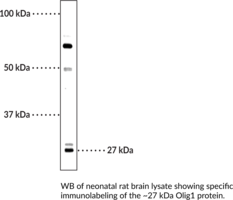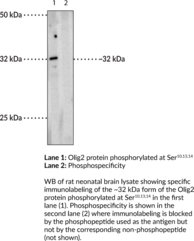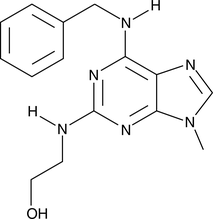Cayman
Showing 33151–33300 of 45550 results
-
Oleoyl serinol is an analog of ceramide and an agonist of the cannabinoid receptor GPR119 that has an EC50 value of 12 µM for stimulating secretion of GLP-1 in mouse endocrine GLUTag cells.{39726} It has been found in E. coli that express human microbiota N-acyl synthase (hmNAS) genes. It induces cell death of F-11 murine neuroblastoma and apoptosis in U-87 human astrocytoma cells when used at a concentration of 100 µM.{10417} Oleoyl serinol (80 µM) induces formation of a complex including PAR-4 and PKCζ in embryoid body-derived cells, decreases the levels of the pluripotency marker Oct-4 and prostate apoptosis response-4 (PAR-4), which mediates ceramide-induced apoptosis in embryonic stem cells.{39727} It induces apoptosis selectively in rapidly dividing cells over differentiated cells as well as prevents teratoma formation and promotes neural differentiation in a neonatal mouse engraftment model of teratoma formation.
Brand:CaymanSKU:-Oleoyl serinol is an analog of ceramide and an agonist of the cannabinoid receptor GPR119 that has an EC50 value of 12 µM for stimulating secretion of GLP-1 in mouse endocrine GLUTag cells.{39726} It has been found in E. coli that express human microbiota N-acyl synthase (hmNAS) genes. It induces cell death of F-11 murine neuroblastoma and apoptosis in U-87 human astrocytoma cells when used at a concentration of 100 µM.{10417} Oleoyl serinol (80 µM) induces formation of a complex including PAR-4 and PKCζ in embryoid body-derived cells, decreases the levels of the pluripotency marker Oct-4 and prostate apoptosis response-4 (PAR-4), which mediates ceramide-induced apoptosis in embryonic stem cells.{39727} It induces apoptosis selectively in rapidly dividing cells over differentiated cells as well as prevents teratoma formation and promotes neural differentiation in a neonatal mouse engraftment model of teratoma formation.
Brand:CaymanSKU:-Oleoyl serinol is an analog of ceramide and an agonist of the cannabinoid receptor GPR119 that has an EC50 value of 12 µM for stimulating secretion of GLP-1 in mouse endocrine GLUTag cells.{39726} It has been found in E. coli that express human microbiota N-acyl synthase (hmNAS) genes. It induces cell death of F-11 murine neuroblastoma and apoptosis in U-87 human astrocytoma cells when used at a concentration of 100 µM.{10417} Oleoyl serinol (80 µM) induces formation of a complex including PAR-4 and PKCζ in embryoid body-derived cells, decreases the levels of the pluripotency marker Oct-4 and prostate apoptosis response-4 (PAR-4), which mediates ceramide-induced apoptosis in embryonic stem cells.{39727} It induces apoptosis selectively in rapidly dividing cells over differentiated cells as well as prevents teratoma formation and promotes neural differentiation in a neonatal mouse engraftment model of teratoma formation.
Brand:CaymanSKU:-Oleoyl serinol is an analog of ceramide and an agonist of the cannabinoid receptor GPR119 that has an EC50 value of 12 µM for stimulating secretion of GLP-1 in mouse endocrine GLUTag cells.{39726} It has been found in E. coli that express human microbiota N-acyl synthase (hmNAS) genes. It induces cell death of F-11 murine neuroblastoma and apoptosis in U-87 human astrocytoma cells when used at a concentration of 100 µM.{10417} Oleoyl serinol (80 µM) induces formation of a complex including PAR-4 and PKCζ in embryoid body-derived cells, decreases the levels of the pluripotency marker Oct-4 and prostate apoptosis response-4 (PAR-4), which mediates ceramide-induced apoptosis in embryonic stem cells.{39727} It induces apoptosis selectively in rapidly dividing cells over differentiated cells as well as prevents teratoma formation and promotes neural differentiation in a neonatal mouse engraftment model of teratoma formation.
Brand:CaymanSKU:-Oleoyl serotonin is a hybrid molecule patterned after arachidonoyl serotonin (Item No. 70665). Arachidonoyl serotonin is a dual antagonist of fatty acid amide hydrolase (FAAH) and the transient receptor potential vanilloid type 1 (TRPV1) channel, reducing both acute and chronic peripheral pain.{18121,18122} Oleoyl Serotonin inhibits capsaicin-induced TRPV1 channel activation (IC50 = 2.57 μM) without blocking FAAH-mediated hydrolysis of arachidonoyl ethanolamine (IC50 > 50 μM).{18121}
Brand:CaymanSKU:9000629 - 10 mgAvailable on backorder
Oleoyl serotonin is a hybrid molecule patterned after arachidonoyl serotonin (Item No. 70665). Arachidonoyl serotonin is a dual antagonist of fatty acid amide hydrolase (FAAH) and the transient receptor potential vanilloid type 1 (TRPV1) channel, reducing both acute and chronic peripheral pain.{18121,18122} Oleoyl Serotonin inhibits capsaicin-induced TRPV1 channel activation (IC50 = 2.57 μM) without blocking FAAH-mediated hydrolysis of arachidonoyl ethanolamine (IC50 > 50 μM).{18121}
Brand:CaymanSKU:9000629 - 100 mgAvailable on backorder
Oleoyl serotonin is a hybrid molecule patterned after arachidonoyl serotonin (Item No. 70665). Arachidonoyl serotonin is a dual antagonist of fatty acid amide hydrolase (FAAH) and the transient receptor potential vanilloid type 1 (TRPV1) channel, reducing both acute and chronic peripheral pain.{18121,18122} Oleoyl Serotonin inhibits capsaicin-induced TRPV1 channel activation (IC50 = 2.57 μM) without blocking FAAH-mediated hydrolysis of arachidonoyl ethanolamine (IC50 > 50 μM).{18121}
Brand:CaymanSKU:9000629 - 5 mgAvailable on backorder
Oleoyl serotonin is a hybrid molecule patterned after arachidonoyl serotonin (Item No. 70665). Arachidonoyl serotonin is a dual antagonist of fatty acid amide hydrolase (FAAH) and the transient receptor potential vanilloid type 1 (TRPV1) channel, reducing both acute and chronic peripheral pain.{18121,18122} Oleoyl Serotonin inhibits capsaicin-induced TRPV1 channel activation (IC50 = 2.57 μM) without blocking FAAH-mediated hydrolysis of arachidonoyl ethanolamine (IC50 > 50 μM).{18121}
Brand:CaymanSKU:9000629 - 50 mgAvailable on backorder
Oleoyl-L-carnitine is a naturally occurring long-chain acylcarnitine.{42574} It inhibits lecithin:cholesterol acyltransferase (LCAT) activity in isolated rat, but not human, plasma by 32% when used at a concentration of 500 µM.
Brand:CaymanSKU:26557 - 10 mgAvailable on backorder
Oleoyl-L-carnitine is a naturally occurring long-chain acylcarnitine.{42574} It inhibits lecithin:cholesterol acyltransferase (LCAT) activity in isolated rat, but not human, plasma by 32% when used at a concentration of 500 µM.
Brand:CaymanSKU:26557 - 5 mgAvailable on backorder
Oleuropein is a polyphenol that is abundant in olive leaves and fruits. Like many polyphenols, oleuropein exhibits antioxidant and free radical-scavenging activities, resulting in a wide range of cellular and physiological effects.{33324} Oleuropein reduces adipogenesis by antagonizing PPARγ and induces autophagy by activating AMPK.{33323} It inhibits proliferation and induces apoptosis in cancer cells but not normal cells.{33321} Oleuropein also has bone-protecting effects in mice and rats.{33322}
Brand:CaymanSKU:21220 -Out of stock
Oleuropein is a polyphenol that is abundant in olive leaves and fruits. Like many polyphenols, oleuropein exhibits antioxidant and free radical-scavenging activities, resulting in a wide range of cellular and physiological effects.{33324} Oleuropein reduces adipogenesis by antagonizing PPARγ and induces autophagy by activating AMPK.{33323} It inhibits proliferation and induces apoptosis in cancer cells but not normal cells.{33321} Oleuropein also has bone-protecting effects in mice and rats.{33322}
Brand:CaymanSKU:21220 -Out of stock
Oleuropein is a polyphenol that is abundant in olive leaves and fruits. Like many polyphenols, oleuropein exhibits antioxidant and free radical-scavenging activities, resulting in a wide range of cellular and physiological effects.{33324} Oleuropein reduces adipogenesis by antagonizing PPARγ and induces autophagy by activating AMPK.{33323} It inhibits proliferation and induces apoptosis in cancer cells but not normal cells.{33321} Oleuropein also has bone-protecting effects in mice and rats.{33322}
Brand:CaymanSKU:21220 -Out of stock
Oleuropein is a polyphenol that is abundant in olive leaves and fruits. Like many polyphenols, oleuropein exhibits antioxidant and free radical-scavenging activities, resulting in a wide range of cellular and physiological effects.{33324} Oleuropein reduces adipogenesis by antagonizing PPARγ and induces autophagy by activating AMPK.{33323} It inhibits proliferation and induces apoptosis in cancer cells but not normal cells.{33321} Oleuropein also has bone-protecting effects in mice and rats.{33322}
Brand:CaymanSKU:21220 -Out of stock
Oleyl alcohol is a monounsaturated fatty alcohol produced by the reduction of oleic acid (Item Nos. 90260 | 24659).{48984} Topical application of an oleyl alcohol (5% w/w), propylene glycol, and Carbopol® 940 gel containing the non-steroidal anti-inflammatory drug (NSAID) piroxicam (Item No. 13368) enhances piroxicam absorption into isolated rat abdominal skin compared to a control gel not containing oleyl alcohol.{48985} Oleyl alcohol also increases naloxone penetration into isolated postmortem human skin when applied at a 10% concentration.{48986}
Brand:CaymanSKU:30385 - 1 gAvailable on backorder
Oleyl alcohol is a monounsaturated fatty alcohol produced by the reduction of oleic acid (Item Nos. 90260 | 24659).{48984} Topical application of an oleyl alcohol (5% w/w), propylene glycol, and Carbopol® 940 gel containing the non-steroidal anti-inflammatory drug (NSAID) piroxicam (Item No. 13368) enhances piroxicam absorption into isolated rat abdominal skin compared to a control gel not containing oleyl alcohol.{48985} Oleyl alcohol also increases naloxone penetration into isolated postmortem human skin when applied at a 10% concentration.{48986}
Brand:CaymanSKU:30385 - 10 gAvailable on backorder
Oleyl alcohol is a monounsaturated fatty alcohol produced by the reduction of oleic acid (Item Nos. 90260 | 24659).{48984} Topical application of an oleyl alcohol (5% w/w), propylene glycol, and Carbopol® 940 gel containing the non-steroidal anti-inflammatory drug (NSAID) piroxicam (Item No. 13368) enhances piroxicam absorption into isolated rat abdominal skin compared to a control gel not containing oleyl alcohol.{48985} Oleyl alcohol also increases naloxone penetration into isolated postmortem human skin when applied at a 10% concentration.{48986}
Brand:CaymanSKU:30385 - 5 gAvailable on backorder
AcylCoA:cholesterol acyltransferase (ACAT) is an intracellular cholesteryl ester synthase tied closely to the absorption of dietary cholesterol.{13122} Oleyl analide (OA) is a weak inhibitor of acylCoA:cholesterol acyltransferase (ACAT) with an IC50 of 26 µM.{12463} OA and the related glyceride dioleoyl phenylamino propane 1,2-diol have been linked to a syndrome of eosinophilia, excessive T-cell activation, and elevated interleukin-4 (IL-4), soluble IL-2R, and IL-5. The clinical consequences are an acute pulmonary inflammatory reaction followed by chronic neuropathy, myalgia, and autoimmune connective tissue disease, generally referred to as toxic oil syndrome (TOS). Aniline-denatured cooking oil is a source of OA associated with TOS.{13123}
Brand:CaymanSKU:10006529 - 10 mgAvailable on backorder
AcylCoA:cholesterol acyltransferase (ACAT) is an intracellular cholesteryl ester synthase tied closely to the absorption of dietary cholesterol.{13122} Oleyl analide (OA) is a weak inhibitor of acylCoA:cholesterol acyltransferase (ACAT) with an IC50 of 26 µM.{12463} OA and the related glyceride dioleoyl phenylamino propane 1,2-diol have been linked to a syndrome of eosinophilia, excessive T-cell activation, and elevated interleukin-4 (IL-4), soluble IL-2R, and IL-5. The clinical consequences are an acute pulmonary inflammatory reaction followed by chronic neuropathy, myalgia, and autoimmune connective tissue disease, generally referred to as toxic oil syndrome (TOS). Aniline-denatured cooking oil is a source of OA associated with TOS.{13123}
Brand:CaymanSKU:10006529 - 100 mgAvailable on backorder
AcylCoA:cholesterol acyltransferase (ACAT) is an intracellular cholesteryl ester synthase tied closely to the absorption of dietary cholesterol.{13122} Oleyl analide (OA) is a weak inhibitor of acylCoA:cholesterol acyltransferase (ACAT) with an IC50 of 26 µM.{12463} OA and the related glyceride dioleoyl phenylamino propane 1,2-diol have been linked to a syndrome of eosinophilia, excessive T-cell activation, and elevated interleukin-4 (IL-4), soluble IL-2R, and IL-5. The clinical consequences are an acute pulmonary inflammatory reaction followed by chronic neuropathy, myalgia, and autoimmune connective tissue disease, generally referred to as toxic oil syndrome (TOS). Aniline-denatured cooking oil is a source of OA associated with TOS.{13123}
Brand:CaymanSKU:10006529 - 5 mgAvailable on backorder
AcylCoA:cholesterol acyltransferase (ACAT) is an intracellular cholesteryl ester synthase tied closely to the absorption of dietary cholesterol.{13122} Oleyl analide (OA) is a weak inhibitor of acylCoA:cholesterol acyltransferase (ACAT) with an IC50 of 26 µM.{12463} OA and the related glyceride dioleoyl phenylamino propane 1,2-diol have been linked to a syndrome of eosinophilia, excessive T-cell activation, and elevated interleukin-4 (IL-4), soluble IL-2R, and IL-5. The clinical consequences are an acute pulmonary inflammatory reaction followed by chronic neuropathy, myalgia, and autoimmune connective tissue disease, generally referred to as toxic oil syndrome (TOS). Aniline-denatured cooking oil is a source of OA associated with TOS.{13123}
Brand:CaymanSKU:10006529 - 50 mgAvailable on backorder
Oleyl trifluoromethyl ketone is an analog of oleic acid (Item No. 90260) in which the COOH group is replaced by trifluoromethyl ketone. It is a potent inhibitor of FAAH, in both human and rat. In transfected COS-7 cells, 10 µM oleyl trifluoromethyl ketone inhibits 95.7% of human FAAH activity and 94.8% of rat FAAH activity.{3310,4352}
Brand:CaymanSKU:62640 - 1 mgAvailable on backorder
Oleyl trifluoromethyl ketone is an analog of oleic acid (Item No. 90260) in which the COOH group is replaced by trifluoromethyl ketone. It is a potent inhibitor of FAAH, in both human and rat. In transfected COS-7 cells, 10 µM oleyl trifluoromethyl ketone inhibits 95.7% of human FAAH activity and 94.8% of rat FAAH activity.{3310,4352}
Brand:CaymanSKU:62640 - 10 mgAvailable on backorder
Oleyl trifluoromethyl ketone is an analog of oleic acid (Item No. 90260) in which the COOH group is replaced by trifluoromethyl ketone. It is a potent inhibitor of FAAH, in both human and rat. In transfected COS-7 cells, 10 µM oleyl trifluoromethyl ketone inhibits 95.7% of human FAAH activity and 94.8% of rat FAAH activity.{3310,4352}
Brand:CaymanSKU:62640 - 5 mgAvailable on backorder
Oleyl trifluoromethyl ketone is an analog of oleic acid (Item No. 90260) in which the COOH group is replaced by trifluoromethyl ketone. It is a potent inhibitor of FAAH, in both human and rat. In transfected COS-7 cells, 10 µM oleyl trifluoromethyl ketone inhibits 95.7% of human FAAH activity and 94.8% of rat FAAH activity.{3310,4352}
Brand:CaymanSKU:62640 - 50 mgAvailable on backorder
Oleyloxyethyl phosphorylcholine is an inhibitor of PLA2 with an IC50 value of 6.2 µM for porcine pancreatic PLA2.{879}
Brand:CaymanSKU:70560 - 1 mgAvailable on backorder
Oleyloxyethyl phosphorylcholine is an inhibitor of PLA2 with an IC50 value of 6.2 µM for porcine pancreatic PLA2.{879}
Brand:CaymanSKU:70560 - 10 mgAvailable on backorder
Oleyloxyethyl phosphorylcholine is an inhibitor of PLA2 with an IC50 value of 6.2 µM for porcine pancreatic PLA2.{879}
Brand:CaymanSKU:70560 - 5 mgAvailable on backorder
Oleyloxyethyl phosphorylcholine is an inhibitor of PLA2 with an IC50 value of 6.2 µM for porcine pancreatic PLA2.{879}
Brand:CaymanSKU:70560 - 50 mgAvailable on backorder
Immunogen: Recombinant mouse Olig1 • Host: Rabbit • Species Reactivity: (+) Human, Mouse, Rat • Applications: ICC, IHC, IP, WB • MW = ~27 kDa
Brand:CaymanSKU:29287- 100 µlOligodendrocyte lineage transcription factor 1 (Olig1) is a basic helix-loop-helix transcription factor that promotes the formation and maturation of oligodendrocytes.{55117} It is expressed in the spinal cord and neuroepithelium of the ventral forebrain, colocalizing with the oligodendrocyte precursor markers Sox10 and Pdgfra. Olig1 is localized to the nucleus at the embryonic stage and is translocated to the cytoplasm after birth.{55118} However, Olig1 is translocated back to the nucleus of oligodendrocyte precursors following a demyelinating injury. Olig1-/- mice exhibit delayed, but not impaired, spinal cord oligodendrocyte differentiation and maturation, indicating that Olig1 is non-essential to oligodendrocyte differentiation.{55119} Olig1 knockdown delays mean disease onset and reduces disease severity in a mouse model of myelin oligodendrocyte glycoprotein-induced experimental autoimmune encephalomyelitis.{55120} Cayman’s Olig1 Polyclonal Antibody can be used for immunocytochemistry (ICC), immunohistochemistry (IHC), immunoprecipitation (IP), and Western blot (WB) applications. The antibody recognizes Olig1 at approximately 27 kDa from human, mouse, and rat samples.
Brand:CaymanSKU:29287 - 100 µlAvailable on backorder
Immunogen: Recombinant mouse Olig1 • Host: Rabbit • Species Reactivity: (+) Human, Mouse, Rat • Applications: ICC, IHC, IP, WB • MW = ~27 kDa
Brand:CaymanSKU:29287- 100 µlAvailable on backorder
Immunogen: Phosphopeptide corresponding to amino acid residues surrounding the phospho-Ser10,13,14 of human Olig2 • Host: Rabbit • Species Reactivity: (+) Human, Mouse, Rat • Applications: WB • MW = ~32 kDa
Brand:CaymanSKU:29289- 100 µlOligodendrocyte lineage transcription factor 2 (Olig2) is a basic helix-loop-helix transcription factor that is essential to the formation of oligodendrocytes and motor neurons in the spinal cord and somatic motor neurons in the hindbrain.{46965} It represses differentiation and sustains the replication-competent state of uncommitted progenitor cells to expand the progenitor cell pool during early development and promotes the cell fate decision to form oligodendrocyte progenitors and motor neurons in the spinal cord during late development. It also suppresses the formation of astrocytes in the spinal cord. Olig2 contains a triple serine motif at positions 10, 13, and 14 near its amino terminus that is subject to phosphorylation.{46966} Phosphorylation of Olig2 at this motif (phospho-Ser10,13,14) is developmentally regulated and decreases as Olig2+ progenitor cells mature into terminally differentiated oligodendrocytes. EB5 neurospheres expressing a triple phosphomimetic mutant of Olig2 induce more rapid tumor formation and decreased survival in mice compared with neurospheres expressing wild-type Olig2. Cayman’s Olig2 (Phospho-Ser10,13,14) Polyclonal Antibody can be used for Western blot (WB) applications. The antibody recognizes Olig2 (phospho-Ser10,13,14) at approximately 32 kDa from human, mouse, and rat samples.
Brand:CaymanSKU:29289 - 100 µlAvailable on backorder
Immunogen: Phosphopeptide corresponding to amino acid residues surrounding the phospho-Ser10,13,14 of human Olig2 • Host: Rabbit • Species Reactivity: (+) Human, Mouse, Rat • Applications: WB • MW = ~32 kDa
Brand:CaymanSKU:29289- 100 µlAvailable on backorder
Immunogen: Recombinant mouse Olig2 • Host: Rabbit • Species Reactivity: (+) Human, mouse, rat • Applications: ICC, IHC, IP, WB • MW = ~32 kDa
Brand:CaymanSKU:29288- 100 µlOligodendrocyte lineage transcription factor 2 (Olig2) is a basic helix-loop-helix transcription factor that is essential to the formation of oligodendrocytes and motor neurons in the spinal cord and somatic motor neurons in the hindbrain.{46965} It represses differentiation and sustains the replication competent state of uncommitted progenitor cells to expand the progenitor cell pool during early development and promotes the cell fate decision to form oligodendrocyte progenitors and motor neurons in the spinal cord during late development. It also suppresses the formation of astrocytes in the spinal cord. Olig2 overexpression enhances oligodendrocyte regeneration and myelin repair in a mouse model of lysophosphatidylcholine-induced demyelination.{56201} Knockdown of Olig2 in neurospheres prevents glioma formation but not neurosphere engraftment in mice.{56202} Cayman’s Olig2 Polyclonal Antibody can be used for immunocytochemistry (ICC), immunohistochemistry (IHC), immunoprecipitation (IP), and Western blot (WB) applications. The antibody recognizes Olig1 at approximately 32 kDa from human, mouse, and rat samples.
Brand:CaymanSKU:29288 - 100 µlAvailable on backorder
Immunogen: Recombinant mouse Olig2 • Host: Rabbit • Species Reactivity: (+) Human, mouse, rat • Applications: ICC, IHC, IP, WB • MW = ~32 kDa
Brand:CaymanSKU:29288- 100 µlAvailable on backorder
Oligomycins are macrolides created by Streptomyces species that can be toxic to other organisms. Different oligomycin isomers are highly specific for the disruption of mitochondrial metabolism. Oligomycin A, a dominant analog of the isomers, is an inhibitor of mitochondrial F1FO ATP synthase that induces apoptosis in a variety of cell types (average GI50 = 270 nM).{20629,20630,20628} Oligomycin A exhibits antifungal, antitumor, and nematocidal activities, but has poor solubility in water and other biocompatible solvents, which limits its clinical application.{20624}
Brand:CaymanSKU:11342 - 1 mgAvailable on backorder
Oligomycins are macrolides created by Streptomyces species that can be toxic to other organisms. Different oligomycin isomers are highly specific for the disruption of mitochondrial metabolism. Oligomycin A, a dominant analog of the isomers, is an inhibitor of mitochondrial F1FO ATP synthase that induces apoptosis in a variety of cell types (average GI50 = 270 nM).{20629,20630,20628} Oligomycin A exhibits antifungal, antitumor, and nematocidal activities, but has poor solubility in water and other biocompatible solvents, which limits its clinical application.{20624}
Brand:CaymanSKU:11342 - 10 mgAvailable on backorder
Oligomycins are macrolides created by Streptomyces species that can be toxic to other organisms. Different oligomycin isomers are highly specific for the disruption of mitochondrial metabolism. Oligomycin A, a dominant analog of the isomers, is an inhibitor of mitochondrial F1FO ATP synthase that induces apoptosis in a variety of cell types (average GI50 = 270 nM).{20629,20630,20628} Oligomycin A exhibits antifungal, antitumor, and nematocidal activities, but has poor solubility in water and other biocompatible solvents, which limits its clinical application.{20624}
Brand:CaymanSKU:11342 - 25 mgAvailable on backorder
Oligomycins are macrolides created by Streptomyces species that can be toxic to other organisms. Different oligomycin isomers are highly specific for the disruption of mitochondrial metabolism. Oligomycin A, a dominant analog of the isomers, is an inhibitor of mitochondrial F1FO ATP synthase that induces apoptosis in a variety of cell types (average GI50 = 270 nM).{20629,20630,20628} Oligomycin A exhibits antifungal, antitumor, and nematocidal activities, but has poor solubility in water and other biocompatible solvents, which limits its clinical application.{20624}
Brand:CaymanSKU:11342 - 5 mgAvailable on backorder
Oligomycins are macrolides created by Streptomyces species that can be toxic to other organisms. Different oligomycin isomers are highly specific for the disruption of mitochondrial metabolism. Oligomycin B is a nonselective inhibitor of the mitochondrial F1FO ATP synthase. Oligomycin B (1-10 μM) can reduce the rate of ATP depletion in myocardial ischemia and decrease calcium-induced calcium release oscillation frequency of rat sensory neurons.{20626,20627}
Brand:CaymanSKU:11343 - 1 mgAvailable on backorder
Oligomycins are macrolides created by Streptomyces species that can be toxic to other organisms. Different oligomycin isomers are highly specific for the disruption of mitochondrial metabolism. Oligomycin B is a nonselective inhibitor of the mitochondrial F1FO ATP synthase. Oligomycin B (1-10 μM) can reduce the rate of ATP depletion in myocardial ischemia and decrease calcium-induced calcium release oscillation frequency of rat sensory neurons.{20626,20627}
Brand:CaymanSKU:11343 - 10 mgAvailable on backorder
Oligomycins are macrolides created by Streptomyces species that can be toxic to other organisms. Different oligomycin isomers are highly specific for the disruption of mitochondrial metabolism. Oligomycin B is a nonselective inhibitor of the mitochondrial F1FO ATP synthase. Oligomycin B (1-10 μM) can reduce the rate of ATP depletion in myocardial ischemia and decrease calcium-induced calcium release oscillation frequency of rat sensory neurons.{20626,20627}
Brand:CaymanSKU:11343 - 5 mgAvailable on backorder
Oligomycins are macrolides created by Streptomyces species that can be toxic to other organisms. Different oligomycin isomers are highly specific for the disruption of mitochondrial metabolism. Oligomycin C is a minor component of the oligomycin complex (Item No. 11341) that acts as an inhibitor of the mitochondrial F1FO-ATP synthase.{27897} Inhibition of the ATP synthase by oligomycins leads to cell death.{30742}
Brand:CaymanSKU:-Available on backorder
Oligomycins are macrolides created by Streptomyces species that can be toxic to other organisms. Different oligomycin isomers are highly specific for the disruption of mitochondrial metabolism. Oligomycin C is a minor component of the oligomycin complex (Item No. 11341) that acts as an inhibitor of the mitochondrial F1FO-ATP synthase.{27897} Inhibition of the ATP synthase by oligomycins leads to cell death.{30742}
Brand:CaymanSKU:-Available on backorder
Oligomycins are macrolides created by Streptomyces species that can be toxic to other organisms through their ability to inhibit mitochondrial membrane-bound ATP synthases. The mitochondrial F1FO ATP synthase can switch to an ATP hydrolase during ischemia, so that, under these conditions, inhibition by oligomycins will reduce ATP depletion rather than block ATP synthesis.{20626} Oligomycin complex is a mixture of oligomycins A (Item No. 11342), B (Item No. 11343), and C. Oligomycin A is a selective inhibitor of mitochondrial F1FO-ATP synthase that induces apoptosis in a variety of cell types (average GI50 = 270 nM).{20629,20630,20628} Oligomycin B is a nonselective inhibitor of ATP synthases. Oligomycin B (1-10 μM) can reduce the rate of ATP depletion in myocardial ischemia and decrease calcium-induced calcium release oscillation frequency of rat sensory neurons.{20626,20627}
Brand:CaymanSKU:11341 - 1 mgAvailable on backorder
Oligomycins are macrolides created by Streptomyces species that can be toxic to other organisms through their ability to inhibit mitochondrial membrane-bound ATP synthases. The mitochondrial F1FO ATP synthase can switch to an ATP hydrolase during ischemia, so that, under these conditions, inhibition by oligomycins will reduce ATP depletion rather than block ATP synthesis.{20626} Oligomycin complex is a mixture of oligomycins A (Item No. 11342), B (Item No. 11343), and C. Oligomycin A is a selective inhibitor of mitochondrial F1FO-ATP synthase that induces apoptosis in a variety of cell types (average GI50 = 270 nM).{20629,20630,20628} Oligomycin B is a nonselective inhibitor of ATP synthases. Oligomycin B (1-10 μM) can reduce the rate of ATP depletion in myocardial ischemia and decrease calcium-induced calcium release oscillation frequency of rat sensory neurons.{20626,20627}
Brand:CaymanSKU:11341 - 10 mgAvailable on backorder
Oligomycins are macrolides created by Streptomyces species that can be toxic to other organisms through their ability to inhibit mitochondrial membrane-bound ATP synthases. The mitochondrial F1FO ATP synthase can switch to an ATP hydrolase during ischemia, so that, under these conditions, inhibition by oligomycins will reduce ATP depletion rather than block ATP synthesis.{20626} Oligomycin complex is a mixture of oligomycins A (Item No. 11342), B (Item No. 11343), and C. Oligomycin A is a selective inhibitor of mitochondrial F1FO-ATP synthase that induces apoptosis in a variety of cell types (average GI50 = 270 nM).{20629,20630,20628} Oligomycin B is a nonselective inhibitor of ATP synthases. Oligomycin B (1-10 μM) can reduce the rate of ATP depletion in myocardial ischemia and decrease calcium-induced calcium release oscillation frequency of rat sensory neurons.{20626,20627}
Brand:CaymanSKU:11341 - 5 mgAvailable on backorder
Oligomycin D is a macrolide antibiotic produced by several species of Streptomyces that inhibits the mitochondrial F1FO-ATPase and is used to uncouple oxidative phosphorylation from electron transport.{28797} Oligomycin D is reported to inhibit K-Ras plasma membrane localization in MDCK cells with an IC50 value of 3.49 nM and is cytotoxic to SW620 colon cancer cells with an IC50 value of 36 µM.{31741}
Brand:CaymanSKU:20184 -Available on backorder
Oligomycin D is a macrolide antibiotic produced by several species of Streptomyces that inhibits the mitochondrial F1FO-ATPase and is used to uncouple oxidative phosphorylation from electron transport.{28797} Oligomycin D is reported to inhibit K-Ras plasma membrane localization in MDCK cells with an IC50 value of 3.49 nM and is cytotoxic to SW620 colon cancer cells with an IC50 value of 36 µM.{31741}
Brand:CaymanSKU:20184 -Available on backorder
Oligomycin E is a minor metabolite of the oligomycin complex (Item No. 11341) produced by several species of Streptomyces. It exhibits relatively weak antifungal activity compared to other oligomycins, yet is active against Gram-positive bacteria and demonstrates strong antitumor activity against HeLa cells (IC50 = 14 ng/ml).{31740}
Brand:CaymanSKU:20185 -Available on backorder
Oligomycin E is a minor metabolite of the oligomycin complex (Item No. 11341) produced by several species of Streptomyces. It exhibits relatively weak antifungal activity compared to other oligomycins, yet is active against Gram-positive bacteria and demonstrates strong antitumor activity against HeLa cells (IC50 = 14 ng/ml).{31740}
Brand:CaymanSKU:20185 -Available on backorder
Olivetolic acid (Item No. 26282) is an analytical reference standard categorized as an intermediate in the phytocannabinoid biosynthetic pathway.{44015} It is a precursor in the synthesis of cannabigerolic acid (CBGA; Item Nos. 20019 | 9001572), Δ9-tetrahydrocannabinol (Δ9-THC; Item Nos. ISO60157 | 12068), and cannabidiol (CBD; Item Nos. ISO60156 | 90080). This product is intended for research and forensic applications.
Brand:CaymanSKU:26282 - 25 mgAvailable on backorder
Olivetolic acid (Item No. 26282) is an analytical reference standard categorized as an intermediate in the phytocannabinoid biosynthetic pathway.{44015} It is a precursor in the synthesis of cannabigerolic acid (CBGA; Item Nos. 20019 | 9001572), Δ9-tetrahydrocannabinol (Δ9-THC; Item Nos. ISO60157 | 12068), and cannabidiol (CBD; Item Nos. ISO60156 | 90080). This product is intended for research and forensic applications.
Brand:CaymanSKU:26282 - 5 mgAvailable on backorder
Olmesartan is a potent and selective non-peptide angiotensin II receptor 1 (AT1) antagonist (IC50s = 7.7 and >100,000 nM for AT1 and AT2, respectively, in a radioligand binding assay).{20965} It reduces contraction of isolated guinea pig aorta induced by angiotensin II (Item No. 17150; pD2 = 9.9) but not phenylephrine (Item Nos. 17205 | 18619) or potassium chloride. Olmesartan (0.01 and 0.03 mg/kg, i.v.) reduces the angiotensin II-induced pressor response in conscious normotensive rats with the maximum effect occurring one hour after administration and decreasing thereafter. The oral prodrug form of olmesartan, olmesartan medoxomil (Item No. 11614), has an increased duration of action with no decrease in efficacy eight hours post administration in normotensive rats.
Brand:CaymanSKU:23412 - 100 mgAvailable on backorder
Olmesartan is a potent and selective non-peptide angiotensin II receptor 1 (AT1) antagonist (IC50s = 7.7 and >100,000 nM for AT1 and AT2, respectively, in a radioligand binding assay).{20965} It reduces contraction of isolated guinea pig aorta induced by angiotensin II (Item No. 17150; pD2 = 9.9) but not phenylephrine (Item Nos. 17205 | 18619) or potassium chloride. Olmesartan (0.01 and 0.03 mg/kg, i.v.) reduces the angiotensin II-induced pressor response in conscious normotensive rats with the maximum effect occurring one hour after administration and decreasing thereafter. The oral prodrug form of olmesartan, olmesartan medoxomil (Item No. 11614), has an increased duration of action with no decrease in efficacy eight hours post administration in normotensive rats.
Brand:CaymanSKU:23412 - 250 mgAvailable on backorder
Olmesartan is a potent and selective non-peptide angiotensin II receptor 1 (AT1) antagonist (IC50s = 7.7 and >100,000 nM for AT1 and AT2, respectively, in a radioligand binding assay).{20965} It reduces contraction of isolated guinea pig aorta induced by angiotensin II (Item No. 17150; pD2 = 9.9) but not phenylephrine (Item Nos. 17205 | 18619) or potassium chloride. Olmesartan (0.01 and 0.03 mg/kg, i.v.) reduces the angiotensin II-induced pressor response in conscious normotensive rats with the maximum effect occurring one hour after administration and decreasing thereafter. The oral prodrug form of olmesartan, olmesartan medoxomil (Item No. 11614), has an increased duration of action with no decrease in efficacy eight hours post administration in normotensive rats.
Brand:CaymanSKU:23412 - 50 mgAvailable on backorder
Olmesartan is a potent and selective non-peptide angiotensin II receptor 1 (AT1) antagonist (IC50s = 7.7 and >100,000 nM for AT1 and AT2, respectively, in a radioligand binding assay).{20965} It reduces contraction of isolated guinea pig aorta induced by angiotensin II (Item No. 17150; pD2 = 9.9) but not phenylephrine (Item Nos. 17205 | 18619) or potassium chloride. Olmesartan (0.01 and 0.03 mg/kg, i.v.) reduces the angiotensin II-induced pressor response in conscious normotensive rats with the maximum effect occurring one hour after administration and decreasing thereafter. The oral prodrug form of olmesartan, olmesartan medoxomil (Item No. 11614), has an increased duration of action with no decrease in efficacy eight hours post administration in normotensive rats.
Brand:CaymanSKU:23412 - 500 mgAvailable on backorder
Olmesartan medoxomil is an orally bioavailable prodrug form of olmesartan (Item No. 23412), a nonpeptide angiotensin II antagonist that is selective for the angiotensin 1 (AT1) receptor over the AT2 receptor.{20965} Olmesartan medoxomil (0.1 mg/kg) inhibits the angiotensin II pressor response in normotensive rats. It reduces both systolic and diastolic blood pressure in fructose-fed rats, a model of insulin resistance, when administered at a dose of 10 mg/kg per day, as well as in chow-fed control animals when administered at a dose of 11.4 mg/kg per day.{42446} Olmesartan medoxomil also inhibits increases in plasma levels of triglycerides and non-esterified fatty acids in fructose-fed rats. Formulations containing olmesartan medoxomil have been used in the treatment of hypertension.
Brand:CaymanSKU:11614 - 10 mgAvailable on backorder
Olmesartan medoxomil is an orally bioavailable prodrug form of olmesartan (Item No. 23412), a nonpeptide angiotensin II antagonist that is selective for the angiotensin 1 (AT1) receptor over the AT2 receptor.{20965} Olmesartan medoxomil (0.1 mg/kg) inhibits the angiotensin II pressor response in normotensive rats. It reduces both systolic and diastolic blood pressure in fructose-fed rats, a model of insulin resistance, when administered at a dose of 10 mg/kg per day, as well as in chow-fed control animals when administered at a dose of 11.4 mg/kg per day.{42446} Olmesartan medoxomil also inhibits increases in plasma levels of triglycerides and non-esterified fatty acids in fructose-fed rats. Formulations containing olmesartan medoxomil have been used in the treatment of hypertension.
Brand:CaymanSKU:11614 - 100 mgAvailable on backorder
Olmesartan medoxomil is an orally bioavailable prodrug form of olmesartan (Item No. 23412), a nonpeptide angiotensin II antagonist that is selective for the angiotensin 1 (AT1) receptor over the AT2 receptor.{20965} Olmesartan medoxomil (0.1 mg/kg) inhibits the angiotensin II pressor response in normotensive rats. It reduces both systolic and diastolic blood pressure in fructose-fed rats, a model of insulin resistance, when administered at a dose of 10 mg/kg per day, as well as in chow-fed control animals when administered at a dose of 11.4 mg/kg per day.{42446} Olmesartan medoxomil also inhibits increases in plasma levels of triglycerides and non-esterified fatty acids in fructose-fed rats. Formulations containing olmesartan medoxomil have been used in the treatment of hypertension.
Brand:CaymanSKU:11614 - 50 mgAvailable on backorder
Olmesartan medoxomil-d6 is intended for use as an internal standard for the quantification of olmesartan medoxomil (Item No. 11614) by GC- or LC-MS. Olmesartan medoxomil is an orally bioavailable prodrug form of olmesartan (Item No. 23412), a nonpeptide angiotensin II antagonist that is selective for the angiotensin 1 (AT1) receptor over the AT2 receptor.{20965} Olmesartan medoxomil (0.1 mg/kg) inhibits the angiotensin II pressor response in normotensive rats. It reduces both systolic and diastolic blood pressure in fructose-fed rats, a model of insulin resistance, when administered at a dose of 10 mg/kg per day, as well as in chow-fed control animals when administered at a dose of 11.4 mg/kg per day.{42446} Olmesartan medoxomil also inhibits increases in plasma levels of triglycerides and non-esterified fatty acids in fructose-fed rats. Formulations containing olmesartan medoxomil have been used in the treatment of hypertension.
Brand:CaymanSKU:25759 - 1 mgAvailable on backorder
Olmesartan medoxomil-d6 is intended for use as an internal standard for the quantification of olmesartan medoxomil (Item No. 11614) by GC- or LC-MS. Olmesartan medoxomil is an orally bioavailable prodrug form of olmesartan (Item No. 23412), a nonpeptide angiotensin II antagonist that is selective for the angiotensin 1 (AT1) receptor over the AT2 receptor.{20965} Olmesartan medoxomil (0.1 mg/kg) inhibits the angiotensin II pressor response in normotensive rats. It reduces both systolic and diastolic blood pressure in fructose-fed rats, a model of insulin resistance, when administered at a dose of 10 mg/kg per day, as well as in chow-fed control animals when administered at a dose of 11.4 mg/kg per day.{42446} Olmesartan medoxomil also inhibits increases in plasma levels of triglycerides and non-esterified fatty acids in fructose-fed rats. Formulations containing olmesartan medoxomil have been used in the treatment of hypertension.
Brand:CaymanSKU:25759 - 500 µgAvailable on backorder
Olodaterol is a selective agonist of β2-adrenergic receptors (β2-ARs; EC50s = 97.7 and 2,725 nM for human β2- and β1-ARs, respectively).{40022} In vivo, olodaterol completely reverses acetylcholine-induced bronchoconstriction without cardiovascular side effects in guinea pigs. It also exhibits dose-dependent bronchoprotection in a beagle model of acetylcholine-induced bronchoconstriction for a period of 24 hours, indicating potential for once-daily dosing.{40023} Formulations containing olodaterol have been used to treat bronchoconstriction associated with chronic obstructive pulmonary disease.{40024}
Brand:CaymanSKU:21794 -Out of stock
Olodaterol is a selective agonist of β2-adrenergic receptors (β2-ARs; EC50s = 97.7 and 2,725 nM for human β2- and β1-ARs, respectively).{40022} In vivo, olodaterol completely reverses acetylcholine-induced bronchoconstriction without cardiovascular side effects in guinea pigs. It also exhibits dose-dependent bronchoprotection in a beagle model of acetylcholine-induced bronchoconstriction for a period of 24 hours, indicating potential for once-daily dosing.{40023} Formulations containing olodaterol have been used to treat bronchoconstriction associated with chronic obstructive pulmonary disease.{40024}
Brand:CaymanSKU:21794 -Out of stock
Olodaterol is a selective agonist of β2-adrenergic receptors (β2-ARs; EC50s = 97.7 and 2,725 nM for human β2- and β1-ARs, respectively).{40022} In vivo, olodaterol completely reverses acetylcholine-induced bronchoconstriction without cardiovascular side effects in guinea pigs. It also exhibits dose-dependent bronchoprotection in a beagle model of acetylcholine-induced bronchoconstriction for a period of 24 hours, indicating potential for once-daily dosing.{40023} Formulations containing olodaterol have been used to treat bronchoconstriction associated with chronic obstructive pulmonary disease.{40024}
Brand:CaymanSKU:21794 -Out of stock
Olodaterol is a selective agonist of β2-adrenergic receptors (β2-ARs; EC50s = 97.7 and 2,725 nM for human β2- and β1-ARs, respectively).{40022} In vivo, olodaterol completely reverses acetylcholine-induced bronchoconstriction without cardiovascular side effects in guinea pigs. It also exhibits dose-dependent bronchoprotection in a beagle model of acetylcholine-induced bronchoconstriction for a period of 24 hours, indicating potential for once-daily dosing.{40023} Formulations containing olodaterol have been used to treat bronchoconstriction associated with chronic obstructive pulmonary disease.{40024}
Brand:CaymanSKU:21794 -Out of stock
Cyclin-dependent kinases (CDKs) are key regulators of cell cycle progression and are therefore promising targets for cancer therapy. Olomoucine is a cdk inhibitor that acts by competing for the ATP binding site of the kinase. This purine derivative is an inhibitor for CDC2/cyclin B (IC50 = 7 µM), Cdk2/cyclin A (IC50 = 7 µM), Cdk2/cyclin E (IC50 = 7 µM), CDK/p35 kinase (IC50 = 3 µM), and ERK1/p44 MAP kinase (IC50 = 25 µM).{15005} Olomoucine inhibits DNA synthesis in interleukin-2 stimulated T lymphocytes, triggers G1 arrest, and is also used to synchronize cells in G1.{15006} This inhibitor can attenuate astroglial proliferation and glial scar formation, decrease lesion cavity and mitigate functional deficits after spinal cord injury (SCI) in rats.{15004} Administration of olomoucine (3 mg/kg/day) to rats after SCI significantly suppressed microglial proliferation and proinflammatory cytokine expression, reduced tissue edema formation, and attenuated the number of apoptotic neurons.{15004}
Brand:CaymanSKU:10010240 - 1 mgAvailable on backorder
Cyclin-dependent kinases (CDKs) are key regulators of cell cycle progression and are therefore promising targets for cancer therapy. Olomoucine is a cdk inhibitor that acts by competing for the ATP binding site of the kinase. This purine derivative is an inhibitor for CDC2/cyclin B (IC50 = 7 µM), Cdk2/cyclin A (IC50 = 7 µM), Cdk2/cyclin E (IC50 = 7 µM), CDK/p35 kinase (IC50 = 3 µM), and ERK1/p44 MAP kinase (IC50 = 25 µM).{15005} Olomoucine inhibits DNA synthesis in interleukin-2 stimulated T lymphocytes, triggers G1 arrest, and is also used to synchronize cells in G1.{15006} This inhibitor can attenuate astroglial proliferation and glial scar formation, decrease lesion cavity and mitigate functional deficits after spinal cord injury (SCI) in rats.{15004} Administration of olomoucine (3 mg/kg/day) to rats after SCI significantly suppressed microglial proliferation and proinflammatory cytokine expression, reduced tissue edema formation, and attenuated the number of apoptotic neurons.{15004}
Brand:CaymanSKU:10010240 - 10 mgAvailable on backorder
Cyclin-dependent kinases (CDKs) are key regulators of cell cycle progression and are therefore promising targets for cancer therapy. Olomoucine is a cdk inhibitor that acts by competing for the ATP binding site of the kinase. This purine derivative is an inhibitor for CDC2/cyclin B (IC50 = 7 µM), Cdk2/cyclin A (IC50 = 7 µM), Cdk2/cyclin E (IC50 = 7 µM), CDK/p35 kinase (IC50 = 3 µM), and ERK1/p44 MAP kinase (IC50 = 25 µM).{15005} Olomoucine inhibits DNA synthesis in interleukin-2 stimulated T lymphocytes, triggers G1 arrest, and is also used to synchronize cells in G1.{15006} This inhibitor can attenuate astroglial proliferation and glial scar formation, decrease lesion cavity and mitigate functional deficits after spinal cord injury (SCI) in rats.{15004} Administration of olomoucine (3 mg/kg/day) to rats after SCI significantly suppressed microglial proliferation and proinflammatory cytokine expression, reduced tissue edema formation, and attenuated the number of apoptotic neurons.{15004}
Brand:CaymanSKU:10010240 - 25 mgAvailable on backorder
Cyclin-dependent kinases (CDKs) are key regulators of cell cycle progression and are therefore promising targets for cancer therapy. Olomoucine is a cdk inhibitor that acts by competing for the ATP binding site of the kinase. This purine derivative is an inhibitor for CDC2/cyclin B (IC50 = 7 µM), Cdk2/cyclin A (IC50 = 7 µM), Cdk2/cyclin E (IC50 = 7 µM), CDK/p35 kinase (IC50 = 3 µM), and ERK1/p44 MAP kinase (IC50 = 25 µM).{15005} Olomoucine inhibits DNA synthesis in interleukin-2 stimulated T lymphocytes, triggers G1 arrest, and is also used to synchronize cells in G1.{15006} This inhibitor can attenuate astroglial proliferation and glial scar formation, decrease lesion cavity and mitigate functional deficits after spinal cord injury (SCI) in rats.{15004} Administration of olomoucine (3 mg/kg/day) to rats after SCI significantly suppressed microglial proliferation and proinflammatory cytokine expression, reduced tissue edema formation, and attenuated the number of apoptotic neurons.{15004}
Brand:CaymanSKU:10010240 - 5 mgAvailable on backorder
Olopatadine is a histamine H1 receptor antagonist (Ki =41 nM).{21941} It is 1,059- and 4,177-fold selective for histamine H1 over H2 and H3 receptors, respectively. Olopatadine inhibits histamine-induced phosphoinositide turnover in isolated human conjunctival epithelial cells, isolated human corneal fibroblasts, and human trabecular meshwork (TM3) cells (IC50s = 9.5, 19, and 39.9 nM, respectively). In vivo, olopatadine inhibits passive cutaneous anaphylaxis in rats (ED50 = 49 µg/kg) and IgG1-mediated bronchoconstriction in ovalbumin-sensitized guinea pigs (ED50 = 30 µg/kg).{21940} Formulations containing olopatadine have been used in the treatment of allergic rhinitis and conjunctivitis, as well as in the treatment of itch in patients with well-controlled urticaria.
Brand:CaymanSKU:11999 - 10 mgAvailable on backorder
Olopatadine is a histamine H1 receptor antagonist (Ki =41 nM).{21941} It is 1,059- and 4,177-fold selective for histamine H1 over H2 and H3 receptors, respectively. Olopatadine inhibits histamine-induced phosphoinositide turnover in isolated human conjunctival epithelial cells, isolated human corneal fibroblasts, and human trabecular meshwork (TM3) cells (IC50s = 9.5, 19, and 39.9 nM, respectively). In vivo, olopatadine inhibits passive cutaneous anaphylaxis in rats (ED50 = 49 µg/kg) and IgG1-mediated bronchoconstriction in ovalbumin-sensitized guinea pigs (ED50 = 30 µg/kg).{21940} Formulations containing olopatadine have been used in the treatment of allergic rhinitis and conjunctivitis, as well as in the treatment of itch in patients with well-controlled urticaria.
Brand:CaymanSKU:11999 - 100 mgAvailable on backorder
Olopatadine is a histamine H1 receptor antagonist (Ki =41 nM).{21941} It is 1,059- and 4,177-fold selective for histamine H1 over H2 and H3 receptors, respectively. Olopatadine inhibits histamine-induced phosphoinositide turnover in isolated human conjunctival epithelial cells, isolated human corneal fibroblasts, and human trabecular meshwork (TM3) cells (IC50s = 9.5, 19, and 39.9 nM, respectively). In vivo, olopatadine inhibits passive cutaneous anaphylaxis in rats (ED50 = 49 µg/kg) and IgG1-mediated bronchoconstriction in ovalbumin-sensitized guinea pigs (ED50 = 30 µg/kg).{21940} Formulations containing olopatadine have been used in the treatment of allergic rhinitis and conjunctivitis, as well as in the treatment of itch in patients with well-controlled urticaria.
Brand:CaymanSKU:11999 - 25 mgAvailable on backorder
Olopatadine is a histamine H1 receptor antagonist (Ki =41 nM).{21941} It is 1,059- and 4,177-fold selective for histamine H1 over H2 and H3 receptors, respectively. Olopatadine inhibits histamine-induced phosphoinositide turnover in isolated human conjunctival epithelial cells, isolated human corneal fibroblasts, and human trabecular meshwork (TM3) cells (IC50s = 9.5, 19, and 39.9 nM, respectively). In vivo, olopatadine inhibits passive cutaneous anaphylaxis in rats (ED50 = 49 µg/kg) and IgG1-mediated bronchoconstriction in ovalbumin-sensitized guinea pigs (ED50 = 30 µg/kg).{21940} Formulations containing olopatadine have been used in the treatment of allergic rhinitis and conjunctivitis, as well as in the treatment of itch in patients with well-controlled urticaria.
Brand:CaymanSKU:11999 - 50 mgAvailable on backorder
Olopatadine-d3 is intended for use as an internal standard for the quantification of olopatadine (Item No. 11999) by GC- or LC-MS. Olopatadine is a histamine H1 receptor antagonist (Ki =41 nM).{21941} It is 1,059- and 4,177-fold selective for histamine H1 over H2 and H3 receptors, respectively. Olopatadine inhibits histamine-induced phosphoinositide turnover in isolated human conjunctival epithelial cells, isolated human corneal fibroblasts, and human trabecular meshwork (TM3) cells (IC50s = 9.5, 19, and 39.9 nM, respectively). In vivo, olopatadine inhibits passive cutaneous anaphylaxis in rats (ED50 = 49 µg/kg) and IgG1-mediated bronchoconstriction in ovalbumin-sensitized guinea pigs (ED50 = 30 µg/kg).{21940} Formulations containing olopatadine have been used in the treatment of allergic rhinitis and conjunctivitis, as well as in the treatment of itch in patients with well-controlled urticaria.
Brand:CaymanSKU:31918 - 1 mgAvailable on backorder
Olprinone is an inhibitor of phosphodiesterase 3 (PDE3; IC50 = 0.35 μM for human cardiac enzyme).{51184} It is selective for PDE3 over PDE1 and PDE2 (IC50s = 150 and 100 μM, respectively). Olprinone induces relaxation of precontracted isolated rabbit renal and carotid arterial rings (IC50s = 40 and 103 nM, respectively).{51185} It reduces infarct size and improves cardiac function in a rat model of myocardial ischemia-reperfusion injury when administered at a dose of 0.6 mg/kg twice per day.{51186} Olprinone (0.2 mg/kg) reduces cortical and striatal damage, as well as reduces injured cerebral tissue nitrotyrosine formation, apoptosis, and levels of inducible nitric oxide synthase (iNOS), IL-1β, and intercellular adhesion molecule 1 (ICAM-1) in a rat model of cerebral ischemia-reperfusion injury.{51187} It inhibits neutrophil infiltration into the lungs and inhibits increases in serum levels of TNF-α and IL-6 in a rat model of LPS-induced lung inflammation when administered at a dose of 0.2 mg/kg.{51188}
Brand:CaymanSKU:28396 - 1 mgAvailable on backorder
Olprinone is an inhibitor of phosphodiesterase 3 (PDE3; IC50 = 0.35 μM for human cardiac enzyme).{51184} It is selective for PDE3 over PDE1 and PDE2 (IC50s = 150 and 100 μM, respectively). Olprinone induces relaxation of precontracted isolated rabbit renal and carotid arterial rings (IC50s = 40 and 103 nM, respectively).{51185} It reduces infarct size and improves cardiac function in a rat model of myocardial ischemia-reperfusion injury when administered at a dose of 0.6 mg/kg twice per day.{51186} Olprinone (0.2 mg/kg) reduces cortical and striatal damage, as well as reduces injured cerebral tissue nitrotyrosine formation, apoptosis, and levels of inducible nitric oxide synthase (iNOS), IL-1β, and intercellular adhesion molecule 1 (ICAM-1) in a rat model of cerebral ischemia-reperfusion injury.{51187} It inhibits neutrophil infiltration into the lungs and inhibits increases in serum levels of TNF-α and IL-6 in a rat model of LPS-induced lung inflammation when administered at a dose of 0.2 mg/kg.{51188}
Brand:CaymanSKU:28396 - 10 mgAvailable on backorder
Olprinone is an inhibitor of phosphodiesterase 3 (PDE3; IC50 = 0.35 μM for human cardiac enzyme).{51184} It is selective for PDE3 over PDE1 and PDE2 (IC50s = 150 and 100 μM, respectively). Olprinone induces relaxation of precontracted isolated rabbit renal and carotid arterial rings (IC50s = 40 and 103 nM, respectively).{51185} It reduces infarct size and improves cardiac function in a rat model of myocardial ischemia-reperfusion injury when administered at a dose of 0.6 mg/kg twice per day.{51186} Olprinone (0.2 mg/kg) reduces cortical and striatal damage, as well as reduces injured cerebral tissue nitrotyrosine formation, apoptosis, and levels of inducible nitric oxide synthase (iNOS), IL-1β, and intercellular adhesion molecule 1 (ICAM-1) in a rat model of cerebral ischemia-reperfusion injury.{51187} It inhibits neutrophil infiltration into the lungs and inhibits increases in serum levels of TNF-α and IL-6 in a rat model of LPS-induced lung inflammation when administered at a dose of 0.2 mg/kg.{51188}
Brand:CaymanSKU:28396 - 25 mgAvailable on backorder
























